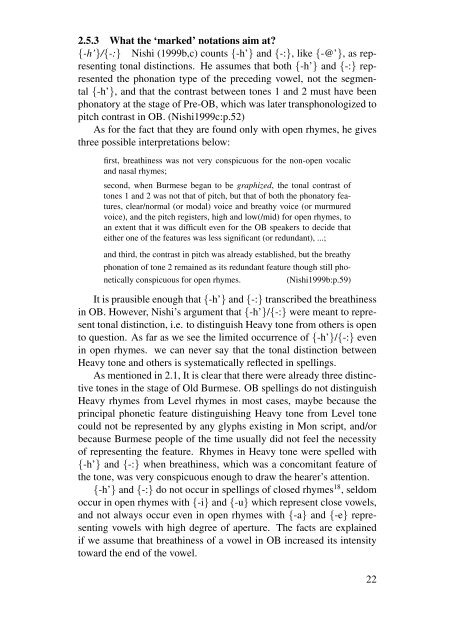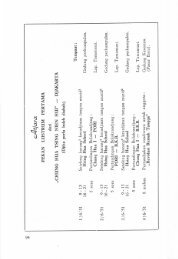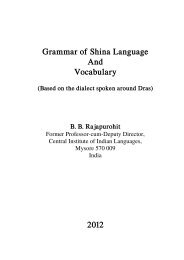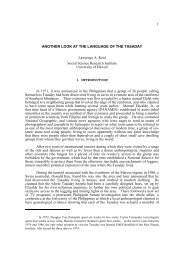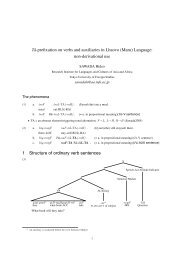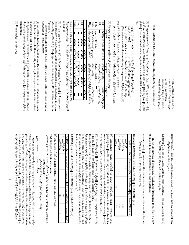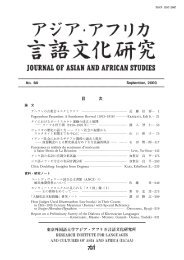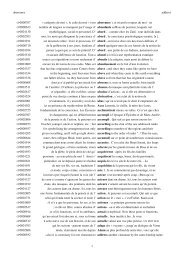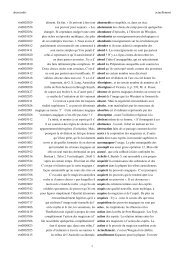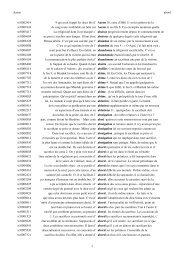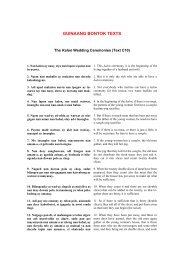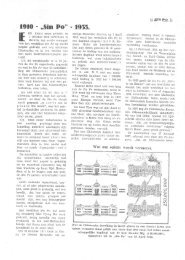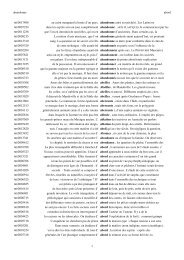Tonal Notation of Indic scripts in Mainland Southeast Asia
Tonal Notation of Indic scripts in Mainland Southeast Asia
Tonal Notation of Indic scripts in Mainland Southeast Asia
Create successful ePaper yourself
Turn your PDF publications into a flip-book with our unique Google optimized e-Paper software.
2.5.3 What the ‘marked’ notations aim at?<br />
{-h’}/{-:} Nishi (1999b,c) counts {-h’} and {-:}, like {-@’}, as represent<strong>in</strong>g<br />
tonal dist<strong>in</strong>ctions. He assumes that both {-h’} and {-:} represented<br />
the phonation type <strong>of</strong> the preced<strong>in</strong>g vowel, not the segmental<br />
{-h’}, and that the contrast between tones 1 and 2 must have been<br />
phonatory at the stage <strong>of</strong> Pre-OB, which was later transphonologized to<br />
pitch contrast <strong>in</strong> OB. (Nishi1999c:p.52)<br />
As for the fact that they are found only with open rhymes, he gives<br />
three possible <strong>in</strong>terpretations below:<br />
first, breath<strong>in</strong>ess was not very conspicuous for the non-open vocalic<br />
and nasal rhymes;<br />
second, when Burmese began to be graphized, the tonal contrast <strong>of</strong><br />
tones 1 and 2 was not that <strong>of</strong> pitch, but that <strong>of</strong> both the phonatory features,<br />
clear/normal (or modal) voice and breathy voice (or murmured<br />
voice), and the pitch registers, high and low(/mid) for open rhymes, to<br />
an extent that it was difficult even for the OB speakers to decide that<br />
either one <strong>of</strong> the features was less significant (or redundant), ...;<br />
and third, the contrast <strong>in</strong> pitch was already established, but the breathy<br />
phonation <strong>of</strong> tone 2 rema<strong>in</strong>ed as its redundant feature though still phonetically<br />
conspicuous for open rhymes. (Nishi1999b:p.59)<br />
It is prausible enough that {-h’} and {-:} transcribed the breath<strong>in</strong>ess<br />
<strong>in</strong> OB. However, Nishi’s argument that {-h’}/{-:} were meant to represent<br />
tonal dist<strong>in</strong>ction, i.e. to dist<strong>in</strong>guish Heavy tone from others is open<br />
to question. As far as we see the limited occurrence <strong>of</strong> {-h’}/{-:} even<br />
<strong>in</strong> open rhymes. we can never say that the tonal dist<strong>in</strong>ction between<br />
Heavy tone and others is systematically reflected <strong>in</strong> spell<strong>in</strong>gs.<br />
As mentioned <strong>in</strong> 2.1, It is clear that there were already three dist<strong>in</strong>ctive<br />
tones <strong>in</strong> the stage <strong>of</strong> Old Burmese. OB spell<strong>in</strong>gs do not dist<strong>in</strong>guish<br />
Heavy rhymes from Level rhymes <strong>in</strong> most cases, maybe because the<br />
pr<strong>in</strong>cipal phonetic feature dist<strong>in</strong>guish<strong>in</strong>g Heavy tone from Level tone<br />
could not be represented by any glyphs exist<strong>in</strong>g <strong>in</strong> Mon script, and/or<br />
because Burmese people <strong>of</strong> the time usually did not feel the necessity<br />
<strong>of</strong> represent<strong>in</strong>g the feature. Rhymes <strong>in</strong> Heavy tone were spelled with<br />
{-h’} and {-:} when breath<strong>in</strong>ess, which was a concomitant feature <strong>of</strong><br />
the tone, was very conspicuous enough to draw the hearer’s attention.<br />
{-h’} and {-:} do not occur <strong>in</strong> spell<strong>in</strong>gs <strong>of</strong> closed rhymes 18 , seldom<br />
occur <strong>in</strong> open rhymes with {-i} and {-u} which represent close vowels,<br />
and not always occur even <strong>in</strong> open rhymes with {-a} and {-e} represent<strong>in</strong>g<br />
vowels with high degree <strong>of</strong> aperture. The facts are expla<strong>in</strong>ed<br />
if we assume that breath<strong>in</strong>ess <strong>of</strong> a vowel <strong>in</strong> OB <strong>in</strong>creased its <strong>in</strong>tensity<br />
toward the end <strong>of</strong> the vowel.<br />
22


